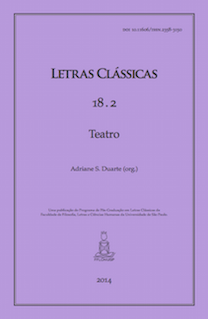O alazôn, o outro e o amigo do outro: teatro da desconfiança na tribuna grega
DOI:
https://doi.org/10.11606/issn.2358-3150.v18i2p74-87Palavras-chave:
Alazôn, comédia antiga, retórica grega, oratóriaResumo
O alazôn aparece com frequência nas comédias de Aristófanes como uma figura de bloqueio que, por meio de seu maior estatuto social, rigidez, vanglória e impostura, tenta impedir a concretização da utopia cômica. O termo também é empregado, na antiguidade grega, para o cavalo de raça (Pólux, Onomástico 1.195), devido à forma imponente com que este sustenta a crina. Além da comédia, a retórica grega também faz uso abundante do termo, geralmente aplicado a um adversário. Uma vez que o desempenho do orador é comparado à disposição do cavalo no hipódromo (Ésquines, Contra Timarco 1.176) e que a algazarra do tribunal ateniense é comparável à do teatro (Platão, República 492b), sugere-se que o topos da alazoneia serve para estigmatizar um personagem (no teatro) ou um orador (na tribuna) como aproveitador, inimigo do bem comum e representante de interesses alheios aos da pólis. Nesse processo, é possível que seu emprego na comédia e na oratória reforce mutuamente o estigma, promovendo uma desconfiança generalizada no orador/alazôn e nas pessoas com ele relacionadas.Downloads
Os dados de download ainda não estão disponíveis.
Downloads
Publicado
2014-11-01
Edição
Seção
Artigos
Licença
Autores que publicam nesta revista concordam com os seguintes termos:
- Autores mantém os direitos autorais e concedem à revista o direito de primeira publicação, com o trabalho licenciado simultaneamente sob uma Licença Creative Commons Attribution 2 anos após a publicação, permitindo o compartilhamento do trabalho com reconhecimento da autoria do trabalho e publicação inicial nesta revista.
- Autores têm autorização para assumir contratos adicionais separadamente, para distribuição não-exclusiva da versão do trabalho publicada nesta revista (ex.: publicar em repositório institucional ou como capítulo de livro), com reconhecimento de autoria e publicação inicial nesta revista.
- Autores têm permissão e são estimulados a publicar e distribuir seu trabalho online (ex.: em repositórios institucionais ou na sua página pessoal) a qualquer ponto antes ou durante o processo editorial, já que isso pode gerar alterações produtivas, bem como aumentar o impacto e a citação do trabalho publicado (Veja O Efeito do Acesso Livre).
Como Citar
Torres, M. L. (2014). O alazôn, o outro e o amigo do outro: teatro da desconfiança na tribuna grega. Letras Clássicas, 18(2), 74-87. https://doi.org/10.11606/issn.2358-3150.v18i2p74-87


